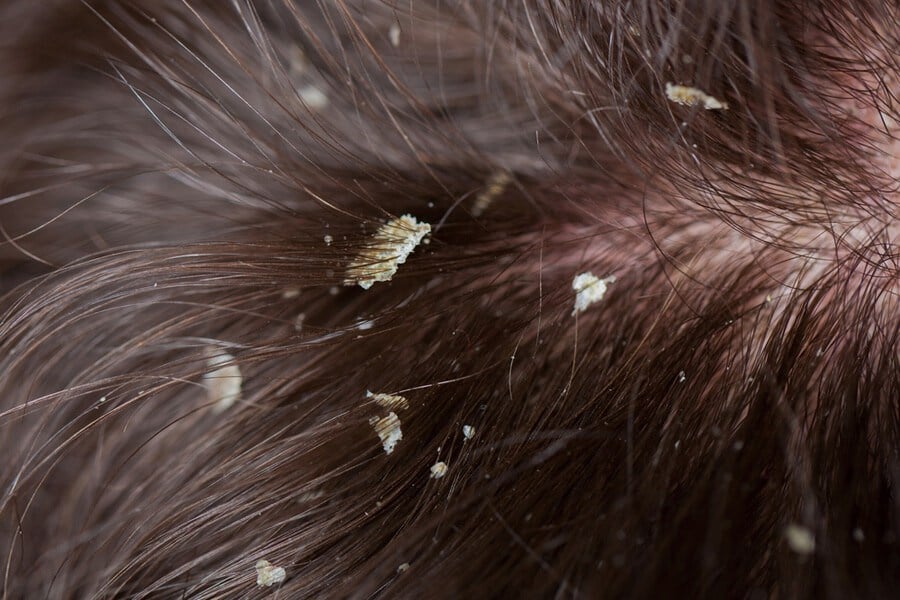From chemical-laden hair products to pollution, sweat, DHT and oil, our scalp and hair come into contact with a lot of hair-damaging elements throughout our day-to-day lives.
Over time, these elements can build up, leaving us with an unhealthy scalp and a less-than-ideal environment for optimum hair growth.
This article will outline:
- The difference between dandruff and epidermis plaque (also known as sebum);
- Ways to get rid of the scalp sebum buildup; and
- How to improve the overall quality of the scalp, hair follicles, and hair.
White Buildup: Dandruff or Sebum?
It is common for individuals with an itchy scalp and irritation to assume the issue is dandruff. However, many conditions can lead to flaking, itching, and inflammation. One such condition is plaque epidermis, also known as scalp, or sebum, buildup
There are a few key differences between dandruff and sebum that allow you to determine which of these is your issue.
Dandruff is fungal. The primary culprit is believed to be the yeast Malassezia.
Sebum buildup, however, is caused by a variety of factors. This includes the use of store-bought shampoos and hair products, as well as contact with pollutants and ineffective scalp cleansing.

Here is how to tell the difference.
Dandruff, for the majority, is clumpy and flaky. It can be white, and sometimes even yellow, and is generally concentrated in particularly oily areas of the scalp.
Sebum, though, has a waxy substance. There will be less flaking and more of an overall buildup. You may experience some itching as a side effect, but it is not an inflammatory issue as is dandruff.
How to Remove the Buildup and Prevent It From Returning
There are two steps you can take to remove the white plaque buildup from your scalp and prevent it from returning in the future. The combination of these steps will leave you with a clean, healthy scalp with ideal conditions for hair growth.
Salicylic Acid Peel
First, you want to remove the scalp buildup and give your scalp a fresh start. Here is how.
What You’ll Need:
- Salicylic acid (15% solution or less)
- Coconut oil
Directions:
Wash your hair and scalp with a gentle cleansing shampoo.
Apply coconut oil to your scalp, enough to cover it in its entirety. Leave the coconut oil to sit on your scalp for 30 minutes.
Now, apply the salicylic acid to your scalp using a small pipette or another instrument. Do so until you have covered all patches of the scalp you would like to target for hair regrowth. Leave the salicylic acid on for 10 minutes, and then gently wash away with warm water.
At this point, there will be patches of salicylic acid peeling off any sebum, dandruff, and dirt from your scalp. If you notice a particularly thick area of sebum, repeat the process outlined above in no less than two days.
Hair Benefits:
This simple yet effective combination is a great way to get your scalp back on track.
As salicylic acid contains a small amount of alcohol, the solution when directly applied can be drying. This is why coconut is first applied and given time to absorb, as it protects your scalp and follicles from drying out and causing further issues.
Cleansing Shampoo
Now that the layer of plaque has been removed, you want to be sure to keep it away for good. For this, it is best to avoid chemical-laden shampoos and stick with a homemade shampoo with simple ingredients.
Ingredients:
- Organic apple cider vinegar (2 tablespoons)
- Baking soda (1 teaspoon)
- Tea tree oil (2 drops) (optional)
- Peppermint oil (2 drops) (optional)
Directions:
Combine the above ingredients, as well as warm water. The apple cider vinegar and baking soda will react, so allow the mixture to settle before using.
Shake before using as the oils do not mix well. Pour the mixture onto your wet hair while in the shower, and massage it into your scalp for three minutes.
Rinse with warm water.
Hair Benefits:
As sebum buildup is caused by ineffective cleansing, the above shampoo will help you to clean your scalp and keep your scalp free from plaque buildup and its ill effects.
Conclusion
White buildup on the scalp is a common issue and one which contributes to hair thinning and loss.
If you are dealing with this issue, then the above two recipes will help you to get your scalp back to its natural, healthy state.
Of course, there are other steps you can take to further prevent the build-up of sebum. These steps include changing your diet and using moisturizing oils, like coconut oil, regularly to prevent scalp dryness and the overproduction of sebum as a result.
Information contained on this website has not been evaluated by any medical body such as the Food & Drug Administration. All information is for educational purposes only. We do not aim to diagnose, treat, cure or prevent any disease or illness. You must consult a medical professional before acting on any content on this website.
